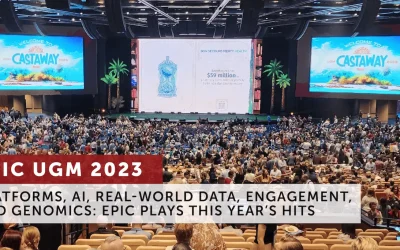HIMSS18 Review 3 of 4
A decade of attending the annual HIMSS conference and I leave both excited and depressed. Excited and enthused by meeting so many people who are dedicating their lives to affect positive change by improving healthcare delivery through IT. Depressed as yet again I find a lack of real leadership and vision among many who repeat the years’ worn phrases of interoperability, patient-centered care, reducing physician burden, and the like.
“Oh please, can’t we just get on with it,” I scream to myself.
In keeping with the bipolar theme that is HIMSS, following are my takeaways, in an up-down fashion.
Up: Anthem goes public on its deal with Epic r/e HealthyPlanet. This partnership is an exciting step in enabling provider-payer convergence wherein Anthem will embed IP (risk, prior authorization, claims adjudication, etc.) into HealthyPlanet and take HealthyPlanet to market with wrap-around services.
Down: Head-in-the-sand vendors who are entrenched in FFS model. These vendors told me point blank that the market will revert back to FFS, that value based care is DOA. Gotta wonder what they’re smoking.
Up: Telehealth going mainstream. Saw loads of examples/demos of telehealth with direct or near-direct integration to the EHR. Been hearing about the coming of telehealth since I started this company in 2007. I believe we are finally there.
Down: Almost zero discussions on managing the costs of care/cost containment. There was some discussion on reducing clinical variability – but beyond that, HIMSS was devoid of any deep conversations on this critical variable in the value equation.
Up: Clear demonstrable, scalable use cases for AI. I was particularly impressed with the work 3M has done with Verily, leveraging Deep Mind technology for specific measures. Though just released, 3M has already landed 17 provider clients and 2 payers.
Down: The preponderance of AI vendors with little sense of scaling their solution. Many of the AI vendors I talked to have ongoing projects with “Big Brand” healthcare systems. That’s great – but disturbingly, few have taken the next step to address how they plan to scale their solution within an organization for widespread adoption and use.
Up: New solutions leveraging FHIR to insert actionable insights directly into clinical workflows. This is near nirvana for me, as it gets beyond the Herculean task of interoperability writ-large and tackles those points where significant friction and opportunity exists.
Down: One policy pundit after another talks yet again about the need for interoperability. Frankly, this is no longer a technical issue. Interoperability is a policy issue and really does not belong at an event such as HIMSS – where we should be talking about the future, not rehashing the past ad nauseum.
Clearly, a lot of work lays ahead for us in the health IT arena, which provides us all meaningful work going forward. And frankly, we are in but the top of the third inning – there is so much to do, it really is an amazing time to be in the healthcare IT market.
Thankfully, we are at last moving beyond the prescriptive use of IT via meaningful use, transitioning to meaningful insights from the data we are collecting and placing into clinical workflows. There is a near unfathomable opportunity to begin leveraging clinical, genomic, and other data sets that will lead us to dramatic improvements in care delivery – improvements that are likely beyond our comprehension at this time.
Despite some of my downer moments at HIMSS18, I could not be more excited for what the future holds for us as an industry – and, personally, in how even I and my care team will leverage new insights to more effectively and efficiently manage my own condition.





Thank you! Your comments are top on my list to review and I appreciate your continued insights!
You’re most welcome Susan.
Thanks for visiting our site and reading our impressions of industry trends, including a few of my own.
The lack of interest in truly addressing healthcare cost growth was palpable. The response of many whom I asked with this technology will reduce cost was either laughter, a blank look or a sincere “it won’t”.
That is indeed a sad testament Bill to where we are today. Even this week while I attended the ACHE Congress I was quite amazed (further saddened) by very little discussion on how we as an industry will begin truly understanding costs of delivered care.
As the old adage goes: You cannot improve what you do not measure.
This industry, still wedded to fee for service, has little impetus to change.
thanks John
i enjoy your perspective – both rich and considered with a great deal of personal and professional experience
You’re most welcome Sue-Ellen.
While I viewed my healthcare tenure as a relatively short 11yrs, it has been one of continuous study, fascination and at times despair. I remain convinced we are on the right track overall but the pace of change can be mind-numbingly frustrating.
Thanks John. As always, your comments are very insightful. Since I retired in 2016, after 40 years in this industry, I now find myself muttering to myself, and occasionally the dog, about many of the things you mention here. I often wonder how far ahead we would be if we did not take one step back for every two we take forward!
Hello Kendra,
Great to hear from you and hope you are enjoying a well-earned retirement.
If you ever get bored, drop me a line.
Cheers,
John
Great insights. I would love to talk more about your view on FHIR. I have heard for that lat 5 years the major vendors conmitnent to this standard. Undortunatley the implementation and execution is poor at best. For example, here in DC, Childrens is not interoperble within the Childrens network as different campuses uses different portals from Cerner. It is so poor.
Agree Pratik, roll-out of FHIR has been far slower than most anticipated, including a a number of EHR vendors. In my conversations with those vendors, virtually all of them have stated that they are waiting for their customers to deploy FHIR across their enterprises. My guess is that by Q3-Q4’18 we will see 30-40% adoption.
Thank you for sharing. I’ve been with the group from here in Brazil. I’ve been working in the area of health here for ten years now and it’s been very rewarding for me.